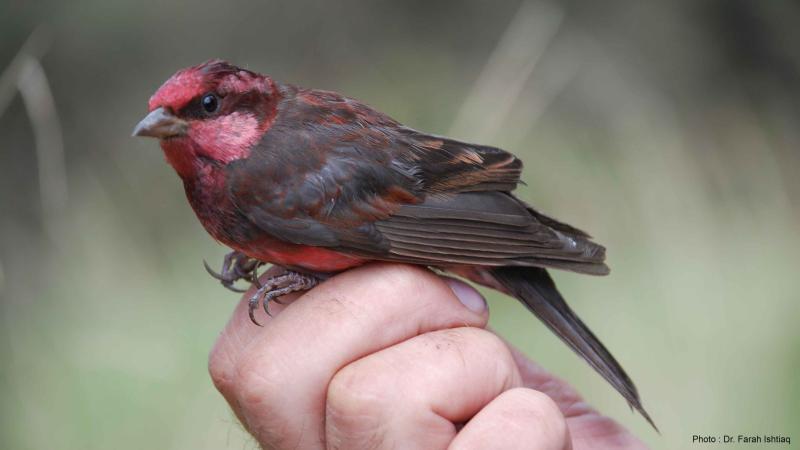
Mountains are harsh, hostile terrains where life does not come easy. But, there are a few plants and animals, including humans (think of the Sherpas of Nepal) that call these lofty peaks home, braving the biting cold! At such heights, oxygen—our essential requirement to live—is scarce too, resulting in hypoxia—a condition where body tissues are starved of oxygen. Hence, these plants and animals have evolved specific adaptations that help them thrive. For example, the Tibetans and Sherpas are bestowed with 'super athlete' gene, which regulates the production of haemoglobin to help them breathe in air that has reduced oxygen.
Birds in the mountains have a greater misery. They are prone to infections by various blood parasites that attack their blood cells, reduce the concentration of haemoglobin and the oxygen-carrying capacity of their blood. So how do they deal with such infections? A Wellcome Trust/DBT India Alliance funded new study by Dr. Farah Ishtiaq and her team from the Centre for Ecological Sciences, Indian Institute of Sciences, Bengaluru, have explored answers to this vital question. The study was conducted on 18 species of passerine birds (birds belonging to the order Passeriformes) across seven elevations in the western Himalayas during the breeding season (April-May) and the non-breeding seasons (January- March).
The birds in the western Himalayas follow two migration strategies. A few of them stay in the higher elevations all year. The others, called ‘elevational migrants’, move to breeding grounds in higher elevations only during the summer and return to the plains during the harsh winter. It is during this time that they are at a higher risk of contracting infections since the birds in the lowlands are loaded with blood parasites, which could compromise the capacity to regulate haemoglobin and cope with hypoxia.
“An earlier study on Himalayan birds showed that they modulate haemoglobin in the blood to increase its oxygen-carrying capacity. In this study, we wanted to understand how these birds deal with the increased demand for oxygen with decreased haemoglobin levels due to infections by parasites”, says Dr. Ishtiaq, talking about the motivation behind this study.
The researchers analysed the parasite DNA in bird blood samples of the 18 species to screen if parasites like Plasmodium, Haemoproteus and Leucocytozoon causing avian malaria were present in them. They also measured the haemoglobin and the percentage of red blood cells in the blood. “Each parasite has a specific vector group. For example, Plasmodium is transmitted by mosquitoes, Haemoproteus by biting midges (Culicoides), and black flies transmit Leucocytozoon. The sexual phase of the parasite takes place in the vector species, and the asexual phase happens in the birds”, explains Dr. Ishtiaq.
The study reveals that high intensity of these blood parasites destroy the red blood cells and reduce the amount of haemoglobin in the migrant birds. When a bird is infected with more than one type of the parasite, it could turn lethal. The researchers found that Leucocytozoon was present in most of the samples, with 40% prevalence, followed by Haemoproteus and Plasmodium. They also found that the probability of infection by Plasmodium was high in the plains and the risk of infection by Leucocytozoon increased with the height.
An interesting finding of the study was that the researchers observed an increased parasite load, a measure of the number and virulence of the parasites in a host, in the non-breeding (winter) season. “This is in stark contrast with previous studies conducted in temperate regions where the intensity of infection was reported to be higher during the breeding season. This contrast for Himalayan birds could be either due to cold weather or poor food availability,” explains Dr. Ishtiaq. They also observed that the intensity of infection decreased with elevation in the breeding season.
Measuring the parasite load is vital to evaluate the role of infections on host fitness and physiology, say the researchers. “Our finding brings a new perspective to disease ecology in high elevation environment where birds are infected with fewer or inactive blood parasite infections”, says Dr. Ishtiaq. “Previous studies have shown that high parasite load is correlated with high mortality rates in human malaria. It is quite possible that a heavy-load of blood parasite infections cause excessive damage to the red blood cells of the seasonal migrants, leading to anaemia, and our experimental result supports the same” she adds.
So, what does the future hold for these birds, considering climate change is affecting the Himalayan ecosystem? The future seems to bleak according to Dr. Ishtiaq. “Temperature plays an important role in regulating the transmission of parasites. With increasing global temperature, the range of mosquitoes and blood parasites might expand to higher elevations. Such a situation might exacerbate hypoxic stress experienced by high elevation birds,” she warns.






